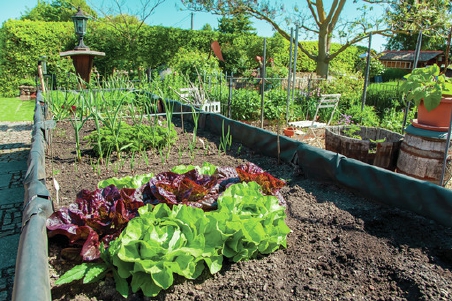By: Karen Cohen
I love chatting about compost, how to make it, what
ingredients make the perfect recipe, and how it improves your soil. I now have the biggest discovery to
share about compost! I found and read a very old copy
of Organic Gardening and Farming from 1968. I was
just a kid back then, but as it turns out, the address label
on it was listed under my mother in law’s name and address (she has passed away), and so I have that warm
fuzzy feeling that she was also an organic gardener. Just
like her son is, and just as I am.
Ok, so here’s the way to make (almost) instant compost, at least that was the way the article was titled!
Only one tool is needed and it can be kept right on your
kitchen countertop all year long. What is it? An electric
blender. That’s right. Once you fully grasp the concept,
you think, wow, why didn’t I think of that before?
I have a Ninja blender that I use to make smoothies and to blend homemade soups. It works with several very sharp blades to slice through veggies like onions, peppers, carrots, anything really that is chopable.
(New word).
Every day we fill it up with banana and
orange peels and pomegranate skins from our morning breakfast, onion heels, leek leaves and stems from
lunch, apple and pear cores from snacks, and anything
veggie-related leftover from dinner, salad greens, etc. I
never put in meat or dairy because that attracts outside
critters. With my lazy fat cats lolling about during daytime hours, I certainly don’t want a wandering raccoon
or possum sniffi ng around the yard.
Permit me to share a funny story. Every night we
bring out cats inside for bedtime. One particular evening it was already dark and I thought all of them were
rounded up and heading inside behind me. When I got
into the living room I noticed my black cat looked a bit
odd. He had a big white streak down his back and at
fi rst I thought he had rubbed against something (white)
outside. But YEEK, it was a skunk milling about with
my cats. In a split second, the front door was torn open
and I corralled the tribe back outside. The skunk followed along. I think it was just as confused as we were
with the assumed acceptance into this little family. No,
no, no. Thank goodness it finally dawned on the skunk
that it did not belong inside a house, nor was it allowed
to get jiggy with my cats. It ran off and did not stop to
spray us. Whew.
So back to compost. Get out your blender or food processor and start making compost. Using all your veggie
and fruit scraps, grind them into tiny pieces. This makes
them decompose MUCH faster in the soil than when
they are whole. I add a bit of water to make a slurry and
then pour it over the garden soil, cover it with soil or dig
it into the ground a bit. The worms love it and go right to
work, eating and producing worm vermicasts. The soil
is enriched just as my body is when I eat these wholesome foods fi lled with minerals and vitamins.
Another item on my kitchen counter is a gallon jar in
which I toss my egg shells. (I don’t put the egg shells
into my blender mix.) When the jar is filled with shells,
I drop them into boiling water to clean out and kill any
possible bacteria in the saved egg shells. Some of the calcium will leach out into the water. Use the water for
your plants when it cools off. I then dump them in a
shallow box and use a rubber mallet to crush them into
small bits. If left somewhat whole, egg shells take forever to break down and you can fi nd them still whole in
your compost pile. So crush them up, then add directly
to your garden soil as a fi ne ground powder. It is estimated that over 150,000 tons of eggshells end up in
the landfills across America! What a waste of a valuable
resource.
Ground egg shells sprinkled around seedlings like lettuce or cucumbers, for instance, can help to deter cutworms or slugs who munch on leaves and lay eggs in
your garden. They don’t like scratchy matter so pile the
crushed egg shells in a circle around each plant to repel
them. Best news: eggshells are a great source for calcium carbonate. This can be used to lower your soil’s
acidity and make it more alkaline. Many common veggies prefer alkaline soil and not acidic soil. Blueberries
are the one item in my garden that thrives on acid soil,
so I keep the shells out of that plot. I pile up pine needles
around my blueberry bushes.
Try some simple ways to repurpose kitchen leftovers.
Help your garden and cut down on trash.
(Karen Cohen is an organic home gardener, photojournalist, and avid explorer. Email your tips and comments to natureswaykaren@gmail.com)



